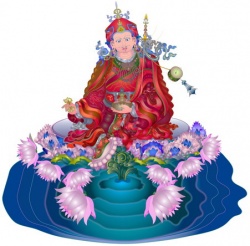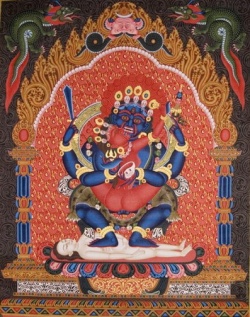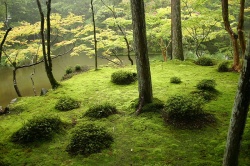Causes of Mental Disorders According to the Tibetan Medical Tradition – An Introduction
Dr. Trogawa Rinpoche
Causes of Mental Disorders
According to the Tibetan Medical Tradition – An Introduction
In previous articles on the Tibetan tradition of medical care presented, we saw that all types of sickness and disease are treated by the root cause.1 The long-term source of any imbalance of the three types of humour (nyi-pa-sum in Tibetan) is the three poisons of desire, aggression and ignorance; the short-term source is imbalanced humours arising from seasonal effects, improper diet and behaviour, furthermore
from the influence of spirits. There are 360 female spirits connected with desire, 360 male spirits connected with aggression and 360 water-dwelling spirits (nagas in Sanskrit, klu in Tibetan) connected with ignorance. Earth spirits (sa-bdag in Tibetan) live in rocks and stones and are connected with ignorance, too. If the mind poisons dominate, any or all spirits harm and can only be pacified through religious practice and rites.
The causes for a mental illness can arise any time in life. Some individuals are born with brain damage, others are born with a strong wind-disorder inflicted while in the womb. How can a wind-disorder of a pregnant woman influence the embryo? A shock, an unpredictable accident, stress or depression influence the development of an embryo and foetus immensely and can be the seed for a mental disorder later, therefore a friendly and beneficial environment is so very important for a mother awaiting a child, especially during the sixth and seventh months of pregnancy. A mental disorder caused by a mother’s
shock can be healed after birth, though. This is why traditional Tibetan medical scriptures also teach how to rear children heedfully, why every Tibetan doctor is very skilled in caring for the young and asks parents to follow the traditional recommendations as early as possible. Nowadays, parents often bring their children to nursery schools and many young ones develop a strong aversion there, which can be quite tedious to surmount later in life. Tibetan families cared for their children without relying upon institutions in the past, but the communists have recently built nursery homes for our children, the first time in the history of my country.
It is very important to encourage youngsters to learn with enthusiasm and joy; it is crucial to stimulate their consciousness and keep them from becoming drowsy and complacent. The annual curriculum at school teaches ways to master challenging phases in life, and every child needs to be gratified with the benefits of succeeding in the onward flowing process and to never be excluded from an active and varied life by falling back when learning to cross thresholds in a competitive world.2 At first, it may seem irrelevant that failing denotes an obstacle, but everyone - especially children - wishes to take root in a corner of the world, otherwise non-identifiable psychic repercussions may arise later.
Highly qualified specialists and scientists are more prone to mental instability because they studied much too long before taking on responsibilities in a job or at work. Scientists are known to be scatterbrains and sometimes resemble sleeping beings lost in automatisms. Many have acquired high academic degrees but often seem to be incapable of dealing with the soil of everyday life - a critical state. Young soldiers sent away to face and deal with hostility and combat return home traumatized, because they were not prepared and rarely receive possibilities to reconstitute themselves in their societies. Young men and women who have not learned to cope with minor responsibilities may never be pushed or forced to deal with stress or violence of any kind, especially the torments that a war always entails.
It is vital for one’s health and well being to become skilled in handling problems, to enjoy the work one does, to appreciate the people one meets and the environment where one lives - stress is no threat for such individuals. On the other hand, it is detrimental for one’s health and well being to fail in handling problems, to dislike the work one does, to despise the people and environment where one lives. As it is, life is an unremitting journey in learning to see through the veil of ignorance that brings on attachment and aversion - continuously. How do the three mind poisons affect health and well being?
In the articles presented in Thar Lam, we looked at the process of being-becoming and saw that attachment and aversion determine life.3 Let us look at how attachment and aversion dominate health and well-being so decisively and how they bring on sickness and disease.
How does attachment cause bad health? When the wish of attaining an aim has been thwarted and brought to nothing, frustration can turn into obsessive greed which fans the winds in the body. Should bad eating habits and an unhealthy lifestyle heap secondary causes on the primary cause, then a derailment arises. A lapse into sickness and disease can be even more threatening if the winds that arise in oneself are suppressed.
Two imbalanced winds usually lead to a mental disorder and must be treated: the wind in the heart (me-nyam-rlung) and the wind in the energy-channel (srog-adzin-rlung). Those who think everything is going wrong and those who are sure that they have had enough of life tend to develop the first imbalance, through “the wind of the heart.” Those who have experienced a sudden shock or have had an unexpected accident tend to develop the second imbalance, through “the life-grasping wind.” Meditation practitioners of tummo4 should know that they are apt to intensify srog-adzin-rlung, “the life-grasping wind,” in their body, so they need to be careful and practice
correctly. Meditators of prana5 (Sanskrit for “breath-control visualizations”) should know that the chakras in their channels could be irreparably damaged if they do not follow the rules and therefore they need to be especially cautious. For example, a prana-practitioner is likely to react with intense fear when someone unexpectedly knocks on his door; a current of fear can soar through the visualized subtle central channel up to the head-chakra, the seat of srog-adzin-rlung, on account of what would otherwise be perceived as a slight irritation. In radical cases of faulty practice, frightening or endangering reports can cause the winds in the body of a prana-practitioner to uncontrollably surge upwards and, as a result, destroy the flow of energy in the body, even retarding the brain and leaving a victim to shake for the rest of his life.
The mind is the initial force that moves the winds in the body; the winds influence the subtle channels, and the body is affected in response. Mental disorders arise due to the imbalanced life-grasping wind as well as the wind of the heart, the sning-rlung. Let us take a closer look at the mind in relation to the winds.
There are so many things we do not like, the reason why we reject so much and develop aggression towards appearances and experiences that are the ingredients of life. Aggression is a hot humour, which some people can deal with quite well. When aggression is suppressed, hot energy is born in the body and heats the blood. Tibetan medical studies tell us that the third bile, sgrub-byed-mkhris-pa (“accomplishing bile”), becomes imbalanced at this point. Furthermore, aggression can perturb the srog-adzin-rlung (“the life-grasping wind”) and raise the blood pressure, harming the heart as a result.
Sometimes mental states affect the body very fast, e.g., when someone becomes angry they can get a headache, or when someone suffers from stress they can get a skin disease very fast. Both symptoms are quite evident, whereas the causes aren’t. Tibetan medical texts therefore teach physicians to recollect embryology first and to take the development of the elements into consideration when diagnosing a sickness or disease. Let me repeat the most important points, which I described in the article Embryology, again: “The human body consists of five elements. Flesh and bones, the nasal faculty and the respective sensory organ, that allows us to smell, develop from the earth element. Blood and bodily fluids,
the tongue faculty and the sensory organ, that make it possible for us to taste, develop from the water element. Bodily temperature and lustre, the visual faculty and the sensory organ, that makes it possible for us to see (both forms and colours), develop from the fire element. Skin, the respiratory system as well as the tactile ability to feel what we touch develop from the wind (air) element. The space element is the fundamental element that provides space for the other four elements to manifest, furthermore, all physical cavities in the joints, bodily openings, the ear faculty and the sensory organ, that enables us to hear, develop through the space element. The five elements are the bases for the physical body and are permeated by an individual’s feelings and thoughts.”
In the article on The Three Humours we also saw that mind and body are intricately connected and that the wind and mind move as a unified pair, even during the bardo, “the intermediate state between death and birth.” Why, then, does the skin become darker and rougher when excessive wind energy flows through the body? The skin is a product of rlung, “the force and energy of wind.” I think the process is as follows: Mental tension disperses the wind energy that influences the skin. That would explain the connection between the mind, its mental states, and skin diseases. Please bear with me while I continue in this line of thought.
Excessive wind disturbs what are called “the five domains of wind disorders,” which are the bones, the ears, the skin, the heart (i.e., the life-force) as well as the large intestine. When wind disorders increase and expand, they move to the seats of the mkhris-pa (“bile”) and bad-kan (“phlegm”) energy forms. It is important to recognize which organ has been affected in order to identify the progression of a disease. Where do the energies of bile and phlegm concentrate in the body and which sickness arises when they are disrupted?
Bile disorders are to be found in the blood, in perspiration, in the eyes, in the doublet of liver and gall bladder and in the small intestine. Disorders of the phlegm energy are complex, can be identified in reliance upon what is called “the seven stages of an organ.” They disrupt nutriment, flesh, fat, marrow and reproduction; the organs affected by bile disorders are the nose, tongue, the lungs, the spleen and kidneys as well as the vascular organs of the
stomach and bladder. Wind disorders develop at one of the spaces mentioned above. If a sickness worsens because of an insufficient diet and a bad lifestyle, it expands and interferes other energy spots. First, the characteristics of the humour changes, e.g., when wind gradually disturbs a respective organ, then both wind and bile are a pair, until the increasing wind energy harms and disrupts the respective energy form. Finally, only the signs of wind are identifiable in places where there should only be signs of bile, for instance. This can also happen when phlegm energy is responsible for the stability of an organ. Imbalances, in any case, lead to displacement of energy forms.6
Question: What do you think about relaxation exercises for patients with neurotic disturbances?
Rinpoche: They seem to be good, although I cannot say anything about them. Intensive physical exertion and exercises seem to help patients with neurotic disorders.7
Thank you very much.
Translated from German and interpreted by Gaby Hollmann.
1 See Dr. Trogawa Rinpoche, Medical Care in the Tibetan Tradition – A Short Introduction in this site.
2 In The Poetics of Space, Gaston Bachelard (1884-1962, one of Europe’s leading philosophers) wrote: “In how many tales of childhood (…) we should be told of a child that, lacking a room, went and sulked in his corner!” Translated from the French by Maria Jolas. Beacon Press, Boston, 1969, p. 14.
3 See specifically my article Medical Care in the Tibetan Tradition – An Introduction.
4 The practice of inner heat generation, one of the Six Yogas of Naropa.
5 Advanced breath control practice from the Mother Tantras of the three tsalung, called nadi, prana, and bindu in Sanskrit.
6 Gaston Bachelard wrote: „Between them they constitute this prodigious, ambivalent teaching which supports the conviction of the heart with the lessons of reality, and which conversely enables us to understand the life of the universe by the life of our hearts.
“All the other elements abound in similar ambivalent certitudes. They suggest secret confessions and display brilliant images.” On Poetic Imagination and Reverie. Selected, translated and introduced by Colette Gaudin. Spring Publ., Putnam, Connecticut, 2005, p. 36.
7 In the same vein, Gaston Bachelard told us: „(...) as soon as the hand takes part in storytelling, as soon as real energies are engaged in a work, as soon as the imagination actualizes its images, the substance of unhappiness dissolves. Action is therefore the negation of unhappiness.” On Poetic Imagination and Reverie, p. 67.





